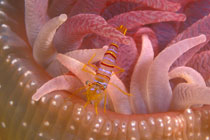Underwater Vancouver
Island is considered by many to offer the best cold-water
diving in the world. Without a doubt, there are only a handful
of sites that come anywhere close to matching the sheer density
of life that is found here.
 |
Giant
Pacific Octopus
Enteroctopus dofleini |
Port Hardy, on
Vancouver Island's North Coast, in particular, is truly
a place unlike many others. (For an excellent article that
really captures some of the magic of Port Hardy, check out
Jett
Britnell's article in Diver Magazine. The trip he describes
is one we were on together in August, 1996.)
It's not that
you tend to see a lot of aquatic life that can't be found
in other locations throughout the region, it's simply that
if a creature exists somewhere in the Pacific Northwest,
chances are you'll encounter it on a regular basis in Port
Hardy. I can't honestly think of a single creature that
I've encountered anywhere in the Pacific Northwest that
I haven't come into contact with here with the exception
of Sixgill Sharks (Hexanchus griseus).
 |
Wolf-Eel
Anarrhichthys ocellatus |
Not only can
everything be found here, aquatic life in Port Hardy tends
to be more -- more friendly as with the many
Wolf-Eels (Anarrhichthys ocellatus) that reside at
Hunt Rock, more profuse as with the density of life
on a dive like Browning Wall, where the brilliant greens,
reds, and oranges rival anything found in the tropics, or
more magical, as with diving with the Pacific White-Sided
Dolphins (Lagenorhychus obliquidens), one of the
few species of wild dolphin that will play with scuba divers
for extended periods of time.
The best time
of the year to dive Port Hardy is from early-April to mid-May
and again from mid-August to mid-October when visibility
is generally 50+ feet and the topside weather is usually
quite nice. Water temperature never gets above the mid to
upper 40s, so a drysuit is a must. In addition to cold water,
very strong currents are a staple of the area. Indeed, Nakwakto
Rapids has the strongest currents in the world, measured
at up to 21 knots! The primary dive site there, Turret Island,
has been nicknamed "Tremble Rock" because it actually vibrates
when currents are at their peak.
 |
Candy
Stripe Shrimp
Lebbeus grandimanus |
The underwater
rewards, however, certainly justify the cost of admission!
In addition to the wolf-eels and dolphins, frequently encountered
inhabitants of the area include the largest species of octopus
in the world -- the Giant Pacific Octopus (Enteroctopus dofleini),
Puget Sound King Crabs (Lopholithodes mandtii), Decorated
Warbonnets (Chirolophis decoratus), Grunt Sculpin
(Rhamphocottus richardsoni), and transparent Candy
Stripe Shrimp (Lebbeus grandimanus).
In place of the schooling reef fish that can be found in the tropics,
Vancouver Island is known for having
very large bottom dwellers such as the Lingcod (Ophiodon
elongatus), who has been known to surpass 5 ft. and the
 |
Gooseneck
Barnacles
Pollicipes polymerus |
Cabezon (Scorpaenichthys marmoratus) who often reaches
4 ft. Also found are masters of camouflage such as the Red
Irish Lord (Hemilepidotus hemilepidotus) and the C-O
Sole (Pleuronichthys coenosus).
The variety and
sheer number of anemones that can be found here is simply
amazing. There are numerous sites that resemble giant snowballs
because of the literally hundreds of thousands of White-Plumed
Anenomes (Metridium giganteum) that cover virtually
every square inch. On just about every wall dive, at least
a half-dozen different species of anemones can be found
within almost any given square yard. These include Crimson
Anenomes (Cribrinopsis fernaldi), Sand-Rose Anenomes
(Urticina columbiana), and Giant Green Anenomes (Anthopleura
xanthogrammica), to name but a few.
 |
Three
Colored Polycera
Polycera tricolor |
Although rarely encountered underwater, topside encounters with pods of
Orca Whales (Orcinus orca) are probably what Vancouver Island is best known
for. Cruising along with these graceful animals truly makes
you appreciate just how amazing nature can be. They alone
make a visit here worthwhile. While visiting Vancouver Island,
I have also occasionally seen Grey Whales (Eschrichtius
robustus) and Humpbacks (Megaptera novaeangliae)
inclduing a very memorable encounter with a mother and her
calf.
I often joke
that if (excuse me, when) I win the lottery, I will
shed my drysuit, 25 lb. weight belt, and 5mm gloves to spend
the remainder of my days diving only tropical locations
with 80+ degree water. That is, with the noted exception
of a regular pilgramage to the Mecca of cold-water diving
-- Port Hardy!
|

